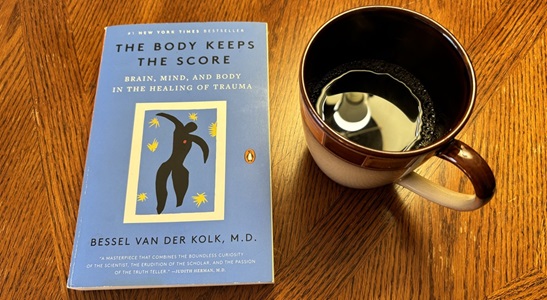Adaptations to Trauma is part ten of my fourteen part commentary and synopsis The Body Keeps the Score by Bessel van der Kolk, and most of this post is a verbatim reprint thereof. Adaptations to trauma can be so severe that health-care providers and patients often believe that full recovery is beyond reach. I was once one of these patients until Eye Movement Desensitizing Reprocessing (EMDR) enabled me to recover from my adaptations to trauma.
1. INTRODUCTION: Childhood Trauma Causes Addiction
2. 12 Steps & 12 Traditions: Damaging Emotional Conflicts
3. Trauma Damages Left Brain Speech
4. BIOFEEDBACK: Meditative States of Consciousness
5. INTEROCEPTION: Traumatic Awareness
6. What Were You Thinking Right Before You Acted Out Your Childhood Trauma?
7. Communication is the Opposite of Trauma
8. ALEXITHYMIA: Inability to Feel Emotion
9. EMDR Reprocesses Body Awareness and Does Not Visit the Original Trauma in Detail
10. EMDR is for Patients So Traumatized That Full Recovery From Adaptations to Trauma is Thought to Be Impossible.
11. Lock Down Your Childhood Trauma Instead of Acting it Out
12. Final Healing: The Patient’s Internal Landscape Manifests Critical Mass of Self
13. Eye Movement Desensitizing Reprocessing of Traumatic Memories

“Traumatized people suffer from many different types of clinical disorders. Dissociative Identity Disorder (DID) at one time was called multiple personality disorder. As dramatic as its symptoms are, the internal splitting and emergence of distinct identities experience in DID represent only the extreme end of the spectrum of mental life.
Adaptations to Trauma
The sense of being inhabited by warring impulses or parts is common to all of us but particularly to traumatized people who had to resort to extreme measures in order to survive. Exploring–even befriending–those parts is an important component of healing.
These adaptations to trauma can so interfere with the capacity to function that health-care providers and patients themselves often believe that full recovery is beyond reach.
We all know what happens when we feel humiliated: We put all our energy into protecting ourselves, developing whatever survival strategies we can. We may repress our feelings; we may get furious and plot revenge. We may decide to become so powerful and successful that nobody can ever hurt us again. Many behaviors that are classified as psychiatric problems, including some obsessions, compulsions, and panic attacks, as well as most self-inflicted destructive behaviors, started out as strategies for self-protection.
Viewing these symptoms as permanent disabilities narrows the focus of treatment to finding the proper drug regimen, which can lead to lifelong dependence–as though traumatized survivors were to be warehoused in a locked psychiatric ward. In my case I have chosen to forgo drug therapy in favor of EMDR therapy, meditation and yoga.
Traumatic Adaptation
It is more productive to see aggression or depression, arrogance or passivity as learned behaviors: Somewhere along the line, the patient came to believe that he or she could survive only if he or she was tough, invisible, or absent, or that it was safer to give up. Some individuals adapt to trauma by adopting eccentric behavior and dress. Like the featured image at the top of this post, people often wear masks as adaptations to trauma. At Unity of the Westside and the Culver City Senior Center there is an eccentric man who relies on humor and double talk as he struts around wearing women’s clothing and jewelry. He often states that he is a child. A problem child is more like it. Although I can see the Christ in this man I have had to create boundaries to keep him from touching my food and my body. At first he bothered me thanks to my EMDR therapist I have established boundaries and can see the teachable moments this character presents. I can see the wounded child within and now I have compassion instead of disgust for him. His adaptations to trauma have enlightened me. I can see my old self in him. His disruptive behavior has facilitated my recovery.

Like traumatic memories that keep intruding until they are laid to rest. Traumatic adaptations continue until the organism feels safe and integrates all the parts of itself that are stuck in fighting or warding off the trauma. I my case I was able to take off my mask of eccentricity and integrate myself into wholeness and oneness with the universe.
Resilience
Every trauma survivor I’ve met is resilient in his or her own way, and every one of their stories inspires awe at how people cope. Knowing how much energy the sheer act of survival requires keeps me from being surprised at the price they often pay: the absence of a loving relationship with their own bodies, minds, and souls. Trauma survivors also often pay the price of an absence of a loving relationship with others.
Coping Takes It’s Toll
For many children it is safer to hate themselves than to risk their relationship with their caregivers by expressing anger or by running away. As a result, abused children are likely to grow up believing that they are fundamentally unlovable; that was the only way their young minds could explain why they were treated so badly. They survive by denying, ignoring, and splitting off large chunks of reality: They forget the abuse; they suppress their rage or despair; they numb their physical sensations. If you were abused as a child, you are likely to have a childlike part living inside of you that is frozen in time, still holding fast to this kind of self-loathing and denial. Many adults who survive terrible experiences are caught in the same trap. Pushing away intense feelings can be highly adaptive in the short run. It may help you preserve your dignity and independence; it may help you maintain focus on critical tasks like saving a comrade, taking care of your kids, or rebuilding your house.
The problems come later
After seeing a friend blown up, a soldier may return to civilian life and try to put the experience out of his mind. A protective part of him knows how to be competent at his job and how to get along with colleagues. But he may habitually erupt in rage at his girlfriend. He may become numb and frozen when the pleasure of surrendering to her touch makes him feel he is losing control. He probably will not be aware that his mind automatically associates passive surrender with the paralysis he felt when his friend was killed. So another protective part steps in to create a diversion. He gets angry. Having no idea what set him off, he thinks he’s mad about something his girlfriend did. Of course, if he keeps blowing up at her (and subsequent girlfriends), he will become more and more isolated. But he may never realize that a traumatized part is triggered by passivity and that another part, an angry manager, is stepping in to protect that vulnerable part. Helping these parts to give up their extreme beliefs is how EMDR therapy can save people’s lives.
As we saw in chapter 23 of The Body Keeps the Score, a central task for recovery from trauma is to learn to live with the memories of the past without being overwhelmed by them in the present. But most survivors, including those who are functioning well–even brilliantly–in some aspects of their lives, face another, even greater challenge; reconfiguring a brain/mind system that was constructed to cope with the worst. Just as we need to revisit traumatic memories in order to integrate them, we need to revisit parts of ourselves that developed the defensive habits that helped us to survive.”
THE MIND IS A MOSAIC
We all have different parts of our personality. Right now a part of me feels like taking a nap; another part wants to keep writing. Still feeling injured by an offensive email message, a part of me wants to hit “reply” and send a stinging put-down, while a different part wants to shrug it off. Most people who know me have seen my intense, sincere, and irritable parts; some have met the little snarling dog that lives inside me.
The different parts within us are just not feelings but distinct ways of being, with their own beliefs, agendas, and roles in the overall ecology of our lives.
How well we get along with ourselves depends largely on our internal leadership skills–how well we listen to our different parts, make sure they feel taken care of, and keep them from sabotaging one another. Parts often come across as absolutes when in fact they represent only one element in a complex constellation of thoughts emotions and sensations. If Margaret shouts, “I hate you!” in the middle of an argument, Joe probably thinks she despises him–and in that moment Margaret might agree. But in fact only a part of her is angry, and that part temporarily obscures her generous and affectionate feelings, which may well return when she sees the devastation on Joe’s face.
Every major school of psychology recognizes that people have subpersonalities and gives them different names. In 1890 William James wrote: “[I]t must be admitted that . . . the possible consciousness may be split into parts which coexist, but mutually ignore each other, and share the objects of knowledge between them. Carl Jung wrote: “The psyche is a self-regulating system that maintains its equilibrium just as the body does.” “The natural state of the human psyche consists in a jostling together of its components and in their contradictory behavior,” and “The reconciliation of these opposites is a major problem. Thus, the adversary is none other than ‘the other in me’.
Modern neuroscience has confirmed this notion of the mind as a kind of society. Michael Gazzaniga, who conducted pioneering split brain research, concluded that the mind is composed of semiautonomous functioning modules, each of which has a special role. In his book The Social Brain (1985) he writes, “But what of the idea that the self is not a unified being, and there may exist within us several realms of consciousness?”



